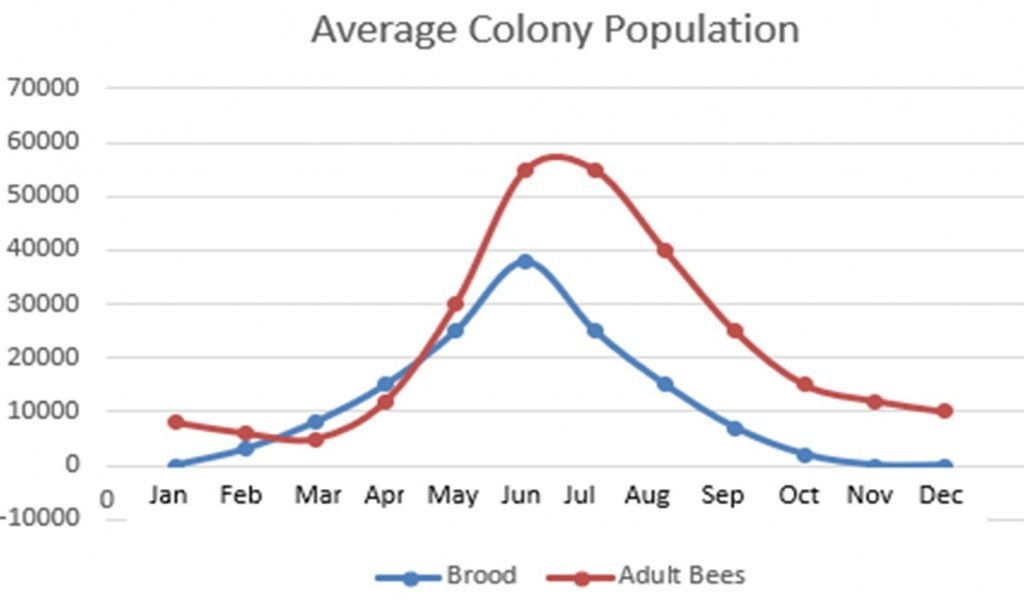In the last article, we learned about honey bee development timelines. Here we will now look at why this information is required. If you have not read Bee timings part 1 please read this first and then come back to this article.
Colony build-up
Colony size is important at all times of the year but especially during the spring build-up. During spring the older winter bees have the difficult task of building up the colonies worker population during often difficult and unpredictable periods. They need an ample amount of pollen, nectar, and workers to ensure this is successful. Some of this will be stored from the previous year but they will also need fresh supplies so a good number of foraging days is required. So how does knowing the timings allow us to understand colony build-up?

Let’s start by looking at the worker bee development timelines based on our simple doubling memory aid. 3 days as an egg, double that to 6 days as a larva (feeding stage), then the cell is sealed for 12 days to allow pupation (metamorphosis stage), giving us 21 days total worker bee development time.
This doubling not only helps us remember the numbers but is what we expect to see within a colony during times of build-up. Most of the cells should contain capped brood (as they are capped for 12 days) , larvae should amount to half the amount of capped (6 days) and half the amount of larvae should be eggs (3 days). In other words a ratio of 1:2:4 – for every egg you find 2 larvae and 4 capped cells.
This is true during colony build up as represented by the average colony population graph shown. If this is not the case further investigations should take place. Remember to also record this down on your hive records (you do have records right?) this will make it easy to see if the colony is building up over a period of time and allows comparisons with other hives you may have.
When to add a super
The general advice is to add your first super when three-quarters of the brood box is full of brood and stores. Subsequent supers are added when the last super is two thirds full of bees. Let’s think about this for a while and again look at timings.

One brood frame of wall to wall brood will yield enough bees to cover approximately two brood frames or three super frames. In order to ensure we are always ahead of the bees requirements we need know when the bees will emerge and when the brood box and super will become populated with bees.
To do this, the brood nest requires examination and notes made of the number of frames of capped worker brood found. From our timing chart, we know worker brood is capped for 12 days. From this we can understand when this brood will emerge and when our next super (or brood box) will need adding. Remember to stay ahead of the bees requirements by giving space at the correct time. Too much space is also counterproductive to colony build up so supering or adding extra brood boxes should be based on colony requirements and careful examination.
Ability to swarm (drones)
Production of drones takes much time and effort for a colony. Drones are fed the longest (7 days) and takes the longest time to pupate. The function of the drone is to mate with virgin queens from other colonies thereby propagating the colony genetics. Early in the season, the priority of a colony is to expand the number of workers they have allowing them to take advantage of the forthcoming forage. Once they are passed that hurdle the colony starts turning its attention to propagating and this is done via the act of swarming. There are many indications a hive is preparing to swarm and one of these is the creation of drone cells. The hive that is creating drones in numbers has reached a strength whereby it now has the ability to swarm.
How does this help? Let’s add an extra date here and look at the time it takes for drones to become mature (fertile and ready to mate). From the time the queen lays an unfertilised egg to the time the drone emerges is 24 days. It takes the drone another 2 weeks before he is mature. When drone cells are first found in a colony, you should make a note of the date in your hive records and the date the drones will emerge, this is a good indication of early swarming timelines. Note: As mentioned this is just one indication, swarming is complex and additional details are required to understand swarm timings fully.
Swarm Cells

This brings us nicely to swarm timelines. This is quite simple to understand (not so easy to manage) but is vital in successful honey bee management. Upon examining a brood box, if queen cells are found containing eggs or larvae (known as charged queen cells) we know the hive will attempt to swarm shortly. But when? Again we need to understand the timings and the stage of the queen cell development.
When a hive swarms, half of the colony (approx) may leave the hive with the old queen (in the swarm) leaving behind capped queen cells. This means the hive will shortly have a new queen and can continue to function. Swarms emerge from a hive the day the queen cell is sealed – day 8 (3 days as an egg, 5 days as a larvae) – this is a golden rule to remember. This is true in all instances unless the weather turns unfavourable or the beekeeper performs some swarm control manipulation.
So when a hive is examined and you find charged queen cells, depending on the development timelines you may have only a few days before a swarm emerges. It makes sense now why most people inspect every 7 days during the swarming season.
Queen Rearing

For anyone wishing to rear their own queens, development timelines are essential. Most people rear queens using a colony set up in a specific way allowing the creation of multiple queen cells. Usually, a hive only tolerates one queen. It is therefore important to distribute the queen cells at the correct time to nucleus colonies or mating nucs. Distribution of the cells needs to happen before any of the reared queens emerges as they can (and probably will) destroy the other cells. Yes, there are ways to cage the cells, however this is not the purpose of our discussion here. Note: Best time to distribute cells are between day 12-14 when the cells are at their hardest and a few days before they emerge.
The table here shows a simple queen rearing timetable. Here you can see the important dates in this process. Note: Day 8 for when the cells are sealed, day 14 to distribute cells and day 16 when the queen emerges.
Re-queening a hive
If you have been keeping bees for a number of years, at some stage you may need to consider re-queening your hive. This may be due to the current queen producing aggressive offspring, death of the current queen, age of the queen, poorly laying queen (badly mated) or to improve the genetics of your hive.
There are many methods of re queening a hive but the general idea is to remove the the old queen (if present) then giving the hive the new queen but ensuring she is released into the hive gradually over a few days, this gives the colony time to get used to the smell / pheromones of their new queen. Further details can be found on Dave Cushmans excellent site – http://www.dave-cushman.net/bee/requeen.html
Varroa Treatments

Most colony treatments for the deadly Varroa mite rely on the honey bee development timelines, and most treatments are ineffective in damaging varroa under capped brood.
Some treatments take 6 weeks (2 full worker bee development cycles) and other take at least 1 full brood cycle. New methods using vaporised oxalic acid mentions treating 3 times 5 days apart (15 days). If you look into this closely you can understand this relates to the time the drone cell is capped. Treating for 15 days means you will ensure all the brood emerges at some stage ensuring you catch the most mites possible.
In the UK only approved methods should be used. These are shown in the table here. An upto date list can be obtained by following this link –
Understanding issues
So finally a few things to remember
If you go into your hive and find no eggs but do find larvae and capped worker brood: This means there was laying queen in the hive between 3-9 days ago (3 days egg, 6 days larve) – ask yourself has she left with a swarm, gone off lay, been damaged, etc?
No larvae is found but you see capped worker brood: This indicates there was a laying queen in the hive between 9-21 days ago (worker brood capped on day 9, and emerges day 21)
No eggs, larvae or capped brood found: Indicates no queen has been laying in the hive for at least 21 days (24 if no drone brood present). Once again examine the hive. Has the hive swarmed over 21 days ago and is now waiting for a new queen to mate? Has the queen gone off lay, is she old and failing, etc.
I am sure you will now appreciate the importance of learning the bee development timelines and some of the reasons why this is important.
